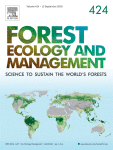Ver ítem
- xmlui.general.dspace_homeCentros Regionales y EEAsCentro Regional Patagonia SurEEA Santa CruzArtículos científicosxmlui.ArtifactBrowser.ItemViewer.trail
- Inicio
- Centros Regionales y EEAs
- Centro Regional Patagonia Sur
- EEA Santa Cruz
- Artículos científicos
- Ver ítem
Masting has different effects on seed predation by insects and birds in antarctic beech forests with no influence of forest management
Resumen
Mast seeding is characteristic of many long-lived tree species and widely proposed as a mechanism to reduce seed predation. However, whether the efficiency of this reproductive response may vary depending on type of seed predator (e.g., invertebrates vs. vertebrates) or depending on local characteristics, remains seldom explored. We evaluated for 8 yrs the patterns of seed production in antarctic beech (Nothofagus antarctica) forests related to management
[ver mas...]
Mast seeding is characteristic of many long-lived tree species and widely proposed as a mechanism to reduce seed predation. However, whether the efficiency of this reproductive response may vary depending on type of seed predator (e.g., invertebrates vs. vertebrates) or depending on local characteristics, remains seldom explored. We evaluated for 8 yrs the patterns of seed production in antarctic beech (Nothofagus antarctica) forests related to management and its influence on insect and bird pre-dispersal seed predation. Along the study, mature seed production was highly variable across years (the population-level coefficient of variation, CVp: 0.98–1.14) and spatially synchronized (Pearson correlation coefficient: 0.83–0.86). Forest type (primary unmanaged, secondary-growth and managed stands) did not influence the amount of seed production nor masting patterns. Mean yearly seed predation by insects was higher than by birds, and their relationship with seeding patterns differed: i.e., while the proportion of seeds predated by insects increased during non-mast years maximum bird predation occurred in mast years. Therefore, predation by insects and birds showed a strong negative relationship. Our results suggest that effectiveness of masting to escape seed predators may be highly depend on the type of predator. We address whether this effect may be due to differences in life history traits among the seed predators involved (i.e., degree of host specificity, dispersal ability or the duration of the life-cycle) and whether an “imperfect” control of avian seed predation may partially be advantageous for the dynamics of the masting species to enhance seed dispersal.
[Cerrar]

Autor
Soler Esteban, Rosina Matilde;
Espelta, Josep Maria;
Lencinas, María Vanessa;
Peri, Pablo Luis;
Martínez Pastur, Guillermo José;
Fuente
Forest Ecology and Management 400 : 173-180 (September 2017)
Fecha
2017-09-15
ISSN
0378-1127
Formato
pdf
Tipo de documento
artículo
Palabras Claves
Derechos de acceso
Restringido
 Excepto donde se diga explicitamente, este item se publica bajo la siguiente descripción: Creative Commons Attribution-NonCommercial-ShareAlike 2.5 Unported (CC BY-NC-SA 2.5)
Excepto donde se diga explicitamente, este item se publica bajo la siguiente descripción: Creative Commons Attribution-NonCommercial-ShareAlike 2.5 Unported (CC BY-NC-SA 2.5)

